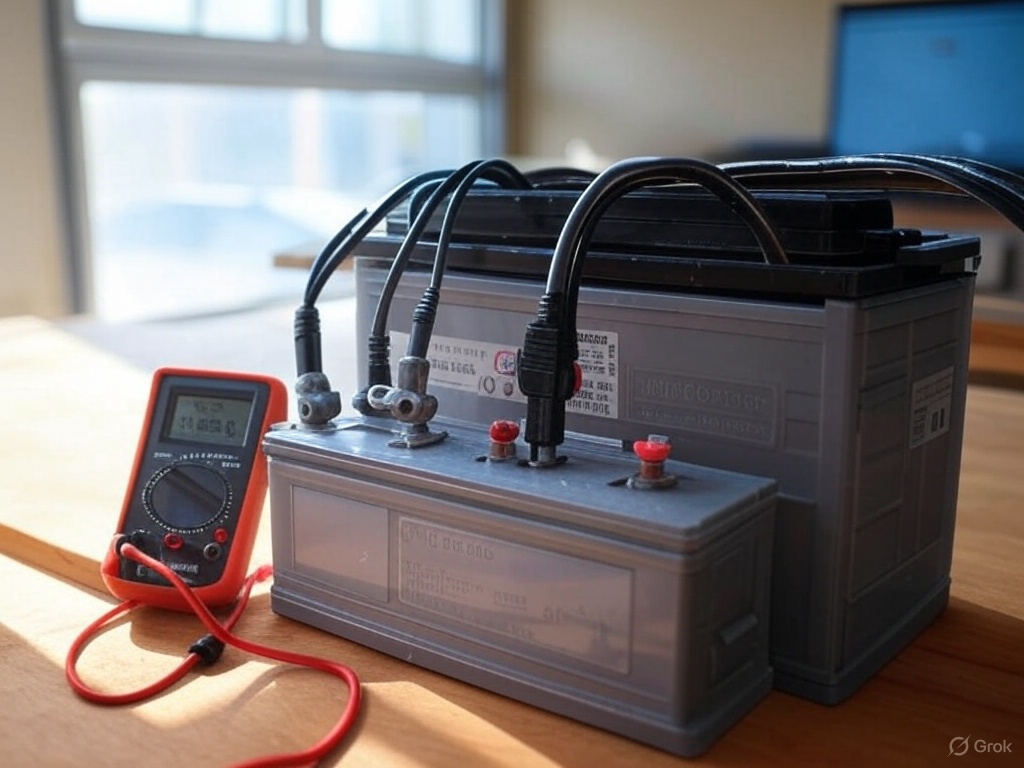Why you should keep an old 12V car battery in case of electrical power grid outages
Using an old 12V car battery as an emergency power bank is a practical idea if the battery still holds a charge or can be recharged. As I have shown in some of my YouTube videos you can connect an inverter to it to have continuous home backup power via your (electric) car. Here’s how you can set it up safely and effectively:
What You’ll Need to use a 12V car battery as an emergency home backup power bank
- Old 12V car battery: Make sure it’s not leaking or damaged (cracked case, corroded terminals). A sulfated or dead battery might still work if revived.
- Battery charger: To recharge the battery if it’s just discharged.
- 12V power inverter: Converts 12V DC to 120V AC (or your local voltage) for common appliances. Get one with enough wattage for your needs (e.g., 300W for small devices, 1000W+ for bigger loads). Make sure to inform yourself if you need a high quality brand pure sine wave inverter for sensitive equipment such as laptops.
- Battery terminals or clamps: For secure connections.
- Fuse or circuit breaker: To protect against short circuits (match the fuse rating to your inverter’s draw—e.g., 30A for a 300W inverter).
- Cables: Heavy-gauge (like 4 AWG) to handle current without overheating.
- Multimeter: To check voltage and ensure the battery’s alive.
- Ventilated space: Batteries can release hydrogen gas, so avoid enclosed areas.
- Optional: A 12V DC socket or USB adapter for direct DC-powered devices (e.g., car chargers).
Steps to use a car battery as a backup power bank
- Test the Battery
- Use a multimeter to check the voltage. A healthy, charged 12V battery should read 12.6V–12.8V. If it’s below 11.8V, it’s discharged; below 10.5V, it might be damaged.
- Charge it fully with a compatible battery charger (trickle or smart charger works best). If it won’t hold a charge after 12–24 hours, it’s likely toast.
- Set Up the Battery
- Place it on a stable, non-conductive surface in a well-ventilated area (garage, shed, etc.).
- Clean the terminals with a wire brush or baking soda/water mix if they’re corroded.
- Connect the Inverter
- Attach the inverter’s positive (red) cable to the battery’s positive terminal and the negative (black) to the negative terminal.
- Install an inline fuse or breaker on the positive cable, as close to the battery as possible, to prevent overloads.
- Double-check connections—loose ones can spark or overheat.
- Test the System
- Turn on the inverter and plug in a small device (like a phone charger or lamp). Check that it works.
- Monitor the battery voltage with the multimeter. If it drops fast (e.g., below 11V in minutes), the battery’s capacity is shot.
- Use It
- For AC devices: Plug them into the inverter (e.g., laptop, small fan).
- For DC devices: Use a 12V socket or adapter directly from the battery (e.g., LED lights, car USB charger).
- Keep loads reasonable—most car batteries are 40–100Ah, so a 300W device might run for 1–3 hours before draining it.
Safety Tips to use a car battery as a power bank for home backup power
- Avoid Over-discharge: Don’t let the voltage drop below 10.5V—deep discharge can kill the battery permanently.
- Charge Regularly: If it sits unused, recharge it every 1–2 months to prevent sulfation.
- Watch for Heat: If the battery or cables get hot, stop and check your setup.
- Handle with Care: Wear gloves and goggles if you suspect leaks—battery acid burns.
Limitations for using a car battery for home backup power
- Capacity fades with age, so an old battery might only power small stuff for a short time (e.g., a 50Ah battery at half capacity gives ~300Wh, or 1 hour of a 300W load).
- It’s not as efficient or portable as a modern power bank, but it’s a solid backup for emergencies like power outages.
Feedback
Have you ever used a car battery as a backup power source during a power outage? How long did you use it during an outage and what appliances were you able to run? Let me know your tips and trick in the comments. Please subscribe to my YouTube channel for more content like this.

